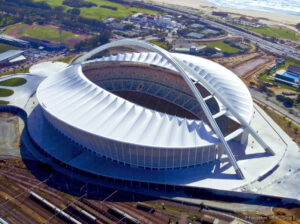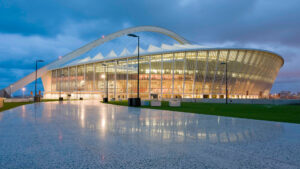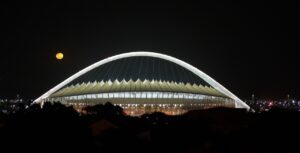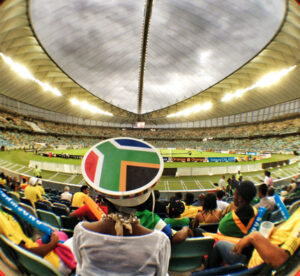Exploring Moses Mabhida Stadium: A Landmark in Durban, South Africa
In the vibrant city of Durban, South Africa, amid the golden beaches and bustling streets, rises a magnificent structure that captures the spirit of a nation. The Moses Mabhida Stadium, named in honor of a revered leader and freedom fighter, is more than just a sports venue—it’s a symbol of unity, resilience, and boundless possibility. Located in the KwaZulu-Natal province, this stadium has become a centerpiece for entertainment, sports, and unforgettable experiences.
Moses Mabhida Stadium right now serves as the home ground for AmaZulu, a team in South Africa’s Premier Soccer League.
A World-Class Venue
The FIFA 2010 World Cup
Back in 2010, when the world’s attention was on South Africa for the FIFA World Cup, Moses Mabhida Stadium shone brightly as one of the host venues. With its sweeping curves and striking architecture, it welcomed thousands of fans, transforming into a pulsating arena of cheers and excitement. Designed to accommodate 55,500 spectators, the stadium could expand to hold up to 75,000, making it perfect for high-capacity events. During the World Cup, it hosted seven crucial matches, including five group games, a round of 16, and even a semi-final. The roar of the crowd echoed through its arches, and the spirit of competition filled the air.
Moses Mabhida Stadium, also known as “Durban Stadium” during the 2010 FIFA World Cup, was one of the key venues for this global event. Over the course of the tournament, the stadium hosted a total of seven matches: five group-stage games, one round-of-16 match, and a semi-final, each filled with intense competition and memorable moments.
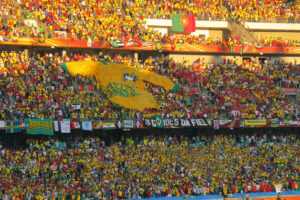
Group Stage Matches
The excitement kicked off on 13 June 2010, when Germany faced off against Australia in a Group D match. The Germans dominated the game, securing a decisive 4-0 victory in front of a roaring crowd of 62,660 fans.
Just three days later, on 16 June, Spain took on Switzerland in a Group H showdown. Despite being the favorites, Spain was stunned by a single Swiss goal, leading to a 0-1 loss. This unexpected result was witnessed by 62,453 spectators.
On 19 June, Group E saw the Netherlands play against Japan in a tightly contested match. The Dutch managed to pull ahead, winning 1-0, with 62,010 fans watching from the stands.
The Group B match on 22 June featured Nigeria and South Korea. It was a nail-biting game that ended in a 2-2 draw, with both teams demonstrating skill and determination. The attendance for this match was 61,874.
Group G’s highly anticipated encounter between Portugal and Brazil on 25 June ended in a goalless draw, but the energy in the stadium was palpable. A total of 62,712 people attended this classic match-up.
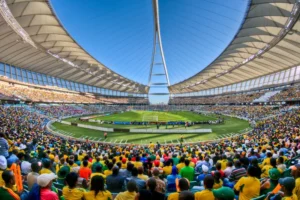
Knockout Rounds
The round-of-16 match on 28 June saw the Netherlands take on Slovakia. The Dutch team triumphed with a 2-1 victory, advancing to the next stage of the tournament. The crowd, numbering 61,962, was enthralled by the skill and precision on display.
Finally, on 7 July, the semi-final between Germany and Spain took place. In a tense and closely fought game, Spain emerged victorious, defeating Germany 1-0. The semi-final drew a crowd of 60,960, with fans from around the world witnessing Spain’s journey to the final.
The 2010 FIFA World Cup at Moses Mabhida Stadium was a historic event, bringing together soccer enthusiasts from across the globe. The stadium’s unique architecture and electric atmosphere made it the perfect venue for some of the tournament’s most unforgettable moments.
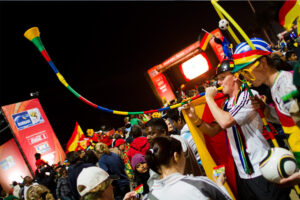
Beyond Soccer: A Multi-Use Marvel
But soccer is just the beginning of the story at Moses Mabhida Stadium. This venue is a chameleon, effortlessly adapting to a wide range of events and activities. From high-flying bungee jumps to electrifying concerts, from intense cricket matches to roaring motorsports, there’s always something happening here. The stadium’s location within the Kings Park Sporting Precinct adds to its versatility, with easy access to other sports facilities like the Kings Park Stadium and the Durban street circuit.
One day, the stadium might be filled with soccer fans cheering on their favorite teams; the next, it could be transformed into a concert venue, with lights and music filling the night sky. The flexibility of the stadium’s design allows it to host events of all sizes, making it a go-to destination for entertainment in Durban.
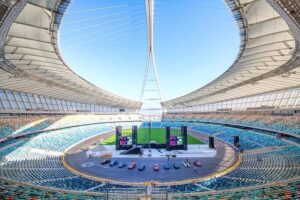
A Hub of Activity and Adventure
If you’re a thrill-seeker, Moses Mabhida Stadium has you covered. The bungee jump from the stadium’s iconic arch offers a heart-pounding experience, while the SkyCar ride to the top of the arch provides breathtaking views of the city and the ocean beyond. The stadium’s multi-purpose nature means that there’s something for everyone, whether you’re an adrenaline junkie or someone who enjoys a relaxed day out watching a rugby game.
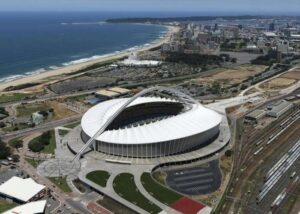
An Iconic Landmark
The Moses Mabhida Stadium isn’t just a venue—it’s a landmark that tells the story of Durban’s growth and transformation. Its striking design, with the sweeping arch and innovative roof structure, draws visitors from all over the world. It’s a place where people come together to celebrate sports, music, and the vibrant culture of South Africa.
As you walk through the stadium’s gates, you can’t help but feel the energy and excitement that pulse through its corridors. The echoes of past events linger in the air, reminding you that you’re standing in a place where history is made and memories are created.
![]()
A Timeline of Construction
Moses Mabhida Stadium’s construction was a significant undertaking. Here is a brief timeline of key milestones:
- 2006-07-08: Demolition of the existing stadium’s southern pavilion.
- 2006-07-12: Demolition of the northern pavilion.
- 2006-07-23: Demolition of the main pavilion.
- 2007-04-01: Construction begins.
- 2008-03-20: Arch construction begins.
- 2009-01-13: Completion of the arch construction.
- 2009-01-01: Aluminum façade construction begins.
- 2009-08-01: Roof cable and membrane work begins.
- 2009-11-24: Official completion of the stadium.
The first official match at the completed stadium took place on 29 November 2009, with Amazulu facing Maritzburg United.
Major Events
Concerts and Festivals
The stadium has hosted several major concerts and festivals, attracting international artists and local talent alike. In December 2015, the award-winning gospel ensemble Joyous Celebration recorded their first outdoor performance at Moses Mabhida Stadium. In 2019, Khuzani Indlamlenze Mpungose held the successful #Gcwalisaimabhida Maskandi music festival, filling the stadium to capacity.
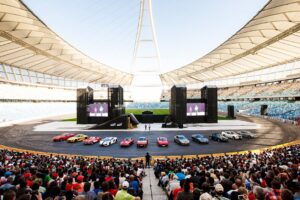
2013 Africa Cup of Nations
Cricket and Other Events
Moses Mabhida Stadium in Durban, South Africa, has hosted one Twenty20 International (T20I) cricket match. This match took place on 9 January 2011 between South Africa and India, as part of the Krish Mackerdhuj Trophy. India won the game by 21 runs, with a crowd of 55,500 spectators, the largest ever for a cricket match on the African continent. Following the match, a concert celebrated the cricket ties between South Africa and India.
Challenges and Changes
The 2022 Commonwealth Games
The stadium was initially scheduled to host the opening ceremony and athletics events for the 2022 Commonwealth Games, which were awarded to Durban in 2015. However, due to funding concerns, the Commonwealth Games Federation withdrew hosting rights in 2017.
Conclusion
Moses Mabhida Stadium is more than just a sports venue; it’s a symbol of unity, resilience, and cultural celebration. From its striking architectural features to its diverse range of events, it continues to draw visitors from around the world. Whether you’re a sports enthusiast, a music lover, or an adventure seeker, this iconic stadium offers something for everyone.
Other Stadiums Articles:
Also Check: Loftus Versfeld Stadium: A Premier Sports and Entertainment Venue
Also Check: FNB Stadium “The Calabash”: South Africa’s Colossal Venue with a Historic Legacy
Also Check: The Story of the Vitality Stadium “Dean Court”: Where Bournemouth’s Heart Beats
Also Check: Victories and Evolution in English Football: Recently opened Stadiums (since 2020)
Also Check: Emirates Stadium (Home of Arsenal): A Journey Through History
Tags: A World-Class Venue, Challenges and Changes, Exploring Moses Mabhida Stadium: A Landmark in Durban, Major Events, South Africa, The Architectural Marvels of Moses Mabhida Stadium
